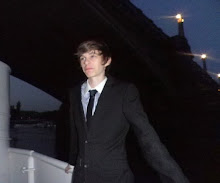Continuity is essential in films, as it prevents the audience from becoming confused, and allows them to understand the story. As the camera cuts between shots, a director would use various techniques to make it clear to the audience what is going on. These techniques/rules make a create a continuous narrative, that all directors strive to achieve. Once the director knows these rules, he/she can break them for effect.
The rules are:
2. 30 degree rule:
1. 180 degree rule:
Never cross the 'line of vision' of two characters, unless you have a master shot that shows the audience where the characters are in relation to each other. This prevent the audience from becoming confused.
2. 30 degree rule:
The camera angle shouldn't change less than 30 degrees (with the same framing,) otherwise, the audience would notice a jump in the footage, making the film seem strange.
3. Shot order:
Use a logical shot order when putting together a film. e.g. long-shot to mid-shot to mid-close-up. This is a lot more easy on the eye then jumping from long shot to close up, and a lot less confusing.
4. Eyeline match:
The direction of characters line of sight should stay the same. For example, if one character is taller then another, then the shorter character should be looking up.
5. Match on action:
You should edit movement 'on the action', so that one scene follows on to the next. For example, if in one scene someone is running, and the scene ends on the characters right leg, then in the next scene, the character should be on still be on his right leg. This makes it clear that the character is moving forward between shots, rather than going back in time.
6. Shot / reverse / shot:
This is where you film a conversation between two characters several times at different angles, and once with a master shot, of both characters together. Then when it comes to editing, you can put together scenes from all of the different angled conversations. This means that the conversation will flow from shot to shot, and the audience won't be confused as to where the two people are in relation to each other.
Making meaning through editing
Transitions
- Cuts - Used to seamlessly move from shot to shot, often used to create pace/rhythm
- Dissolves - Used to create a slow / relaxed link between shots, often used in montage sequences.
- Fades - Often used to show a significant period of time has elapsed between shots.
Sound
- Diegetic sound - Sound that we think is happening in the scene, but has actually been added in by a 'Foley artist.' For example the sound of thunder.
- Non-diegetic sound - Sound that we know isn't part of the scene. For example a voice-over.
- Sound bridge - Used to link two scenes.
Lighting
- High key - Bright and low contrast.
- Low key - More pronounce shadows.
- Lighting from below - Used to make the subject appear threatening.
- Back lighting - Used to create a 'halo effect' around the subject.
Colour
Cold or blue-ish lighting can create a sense of isolation or alienation, whereas warm or yellowish lighting, can create cosiness, or comfort.
Camera movement
- Track - Camera moves towards or away from subject.
- Pan - Pivoting camera to the side, often used to set the scene.
- Whip pan - A sudden, fast pan.
- Tilt - Pivoting the camera up or down.
- Arc - Moving camera in an arc around the subject.
- Crane shot - Camera moves up or down.
- Hand-held shot - Camera held in hand, often used to create a sense of immediacy.
Framing
- Very long shot - Figures appear small in the landscape, often used as an 'establishing shot.'
- Long shot - Figure seen from head to toe.
- Mid shot - Figure seen from waist to head.
- Medium close-up - From chest to head.
- Close-up - Head and shoulders.
- Big close up - Head only. - often used to show emotion.
- Extreme close up - From mouth to eyebrows. - often used to make subject seem threatening.
How will this be useful to my own film making?
I have all of the rules of continuity to bare in mind when making my own film. I also understand how to create meaning through the way I edit and film my film, which will be very useful to the whole process. In our accidents task, we made many of the mistakes that have been highlighted above, however we weren't aloud to edit our sequence. We did try to incorporate some of the continuity techniques we already new, but it looked fairly unconvincing as we slipped up in other places. With the skills I have now learnt I will be able to avoid these mistake during our prelim task.


0 comments:
Post a Comment